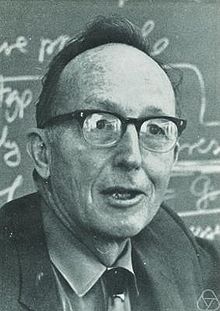Saunders Mac Lane
| Saunders Mac Lane | |
|---|---|
 |
|
| Born |
4 August 1909 Taftville, Connecticut |
| Died | 14 April 2005 (aged 95) San Francisco |
| Nationality | United States |
| Fields | Mathematics |
| Institutions |
Harvard University Cornell University University of Chicago Columbia University |
| Alma mater |
Yale University University of Chicago University of Göttingen |
| Doctoral advisor |
Hermann Weyl Paul Bernays |
| Doctoral students |
Steve Awodey David Eisenbud William Howard Irving Kaplansky Roger Lyndon Michael D. Morley Anil Nerode Robert Solovay John G. Thompson |
| Known for |
Category Theory Mathematical logic Algebraic number theory Algebraic topology |
| Notable awards |
Chauvenet Prize (1941) Leroy P. Steele Prize (1986) National Medal of Science (1989) |
Saunders Mac Lane (4 August 1909 – 14 April 2005) was an American mathematician who co-founded category theory with Samuel Eilenberg.
Mac Lane was born in Norwich, Connecticut, near where his family lived in Taftville. He was christened "Leslie Saunders MacLane", but "Leslie" fell into disuse because his parents, Donald MacLane and Winifred Saunders, came to dislike it. He began inserting a space into his surname because his first wife found it difficult to type the name without a space. He was the oldest of three brothers; one of his brothers, Gerald MacLane, also became a mathematics professor at Rice University and Purdue University. Another sister died as a baby. His father and grandfather were both ministers; his grandfather had been a Presbyterian, but was kicked out of the church for believing in evolution, and his father was a Congregationalist. His mother, née Winifred Saunders, studied at Mount Holyoke College and taught English, Latin, and mathematics.
In high school, Mac Lane's favorite subject was chemistry. While in high school, his father died, and he came under his grandfather's care. His half-uncle, a lawyer, determined to send him to Yale University, where many of his relatives had been educated, and paid his way there beginning in 1926. As a freshman, he became disillusioned with chemistry. His mathematics instructor, Lester S. Hill, coached him for a local mathematics competition which he won, setting the direction for his future work. He went on to study mathematics and physics as a double major, taking courses from Jesse Beams, Ernest William Brown, Ernest Lawrence, F. S. C. Northrop, and Øystein Ore, among others. He graduated from Yale with a B.A. in 1930. During this period, he published his first scientific paper, in physics and co-authored with Irving Langmuir.
...
Wikipedia
